How Did Pumpkin Become Beloved? Labor, Nostalgia, Refreshment And White Women
by Johannah King-Slutzky
This story begins, like so many before it, with a marathon session of “Sabrina, the Teenage Witch.” Specifically, the show’s 1999 Halloween episode, “Episode LXXXI: The Phantom Menace.” (STTW has a real gift for prophecy.) Sabrina, played by Melissa Joan Hart, is a faux black sheep with a heart of gold; her manager (cum boyfriend cum soon-to-be-war-photographer) is as auspicious as he is handsome — which is a lot — but is also a bit dunderheaded. The setting: a Central Perk knockoff:
JOSH: Y’know, I’m really surprised our special pumpkin flavored coffee hasn’t been more popular.
SABRINA: Do you think it has anything to do with the fact that it’s a hideous shade of orange and tastes like pumpkin?
It’s 1999, four full years before Starbucks will introduce the Pumpkin Spice Latte. The scene is played for easy laughs. But two years later (in “Making The Grade,” aired 2 Feb, 2001)…
JOSH: A pumpkin bagel comin’ up. [Walks to counter.] Hey, where are the pumpkin bagels?
HILDA: In the pumpkin bagel patch?
JOSH: Huh?
HILDA: In the interest of lowering overhead we are no longer in the exotic carbohydrate business. […]
JOSH: Hilda, we have an eclectic, sophisticated clientele, all right?
It’s still two years before the advent of the Pumpkin Spice Latte. But pumpkin’s transformation from rube holiday fare to the “exotic carb” of sophisticates was centuries in the making. Probably without realizing it, the sitcom savants at “Sabrina” had tapped into a set of particularly American themes (the celebration and denigration of farm life, anxiety over work ethic, a sturdy fetish for the authentic) that have been playing through the scrim of pumpkin iconography since Pilgrim hit rock in 1620.
Long haul historical materialism suits our favorite gourd (squash, if you’re feeling sober), but pumpkin’s story isn’t over, either: when I checked Google Ngrams it showed a substantial uptick in pumpkin buzz beginning around 1960:
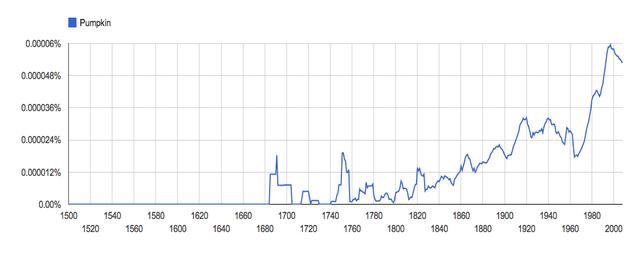
This graph isn’t entirely fair, as pumpkin used to go by “pompion” — that is, when it was differentiated from squash at all — but you get the gist.
What’s giving pumpkin its added boost? For starters, it probably has something to do with the Pumpkin Spice Latte (PSL), which celebrated its 10th birthday this fall. I emailed Starbucks to ask about the drink’s branding; they declined to comment. Instead, let’s check out Instagram.
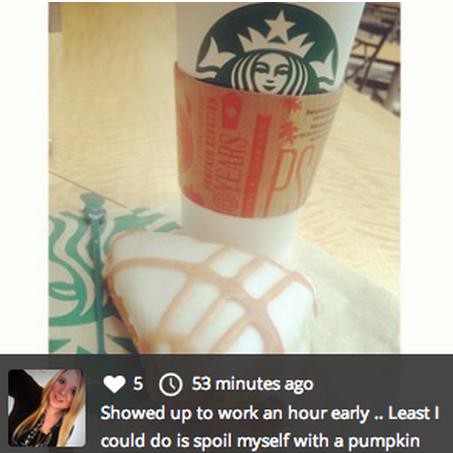
Desktop title: “I spoiled myself.”
These were all taken on September 3, the day the Pumpkin Spice Latte officially debuted for its 10 year anniversary. The themes are remarkably consistent with fruit’s historical lineage, with the drink — which does not contain any actual pumpkin — marking seasons, labor, decadence, and moral submission.

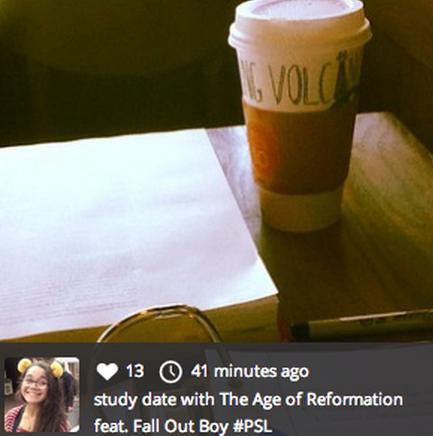
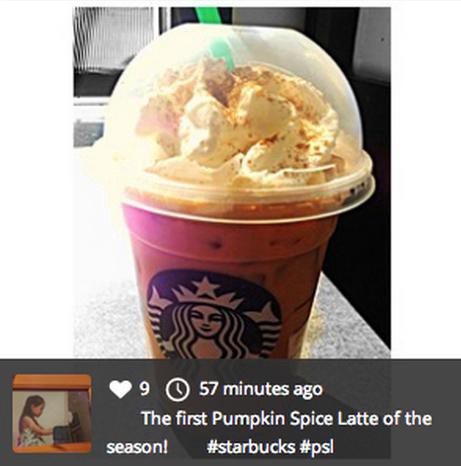
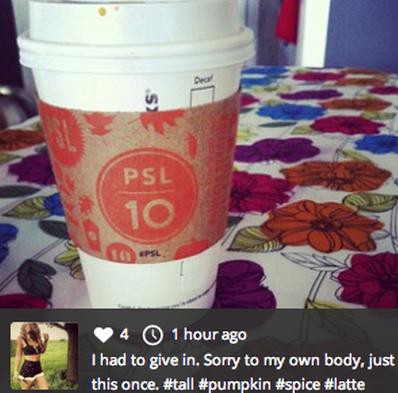
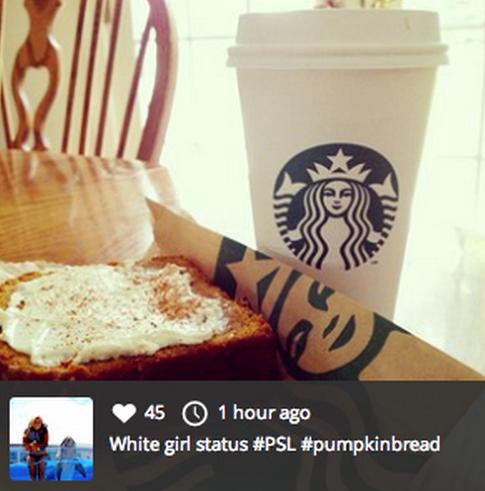
Delighted by casual racism and my own maverick sense of punch, I decided to search twitter for “#whitegirltweet” on a whim.
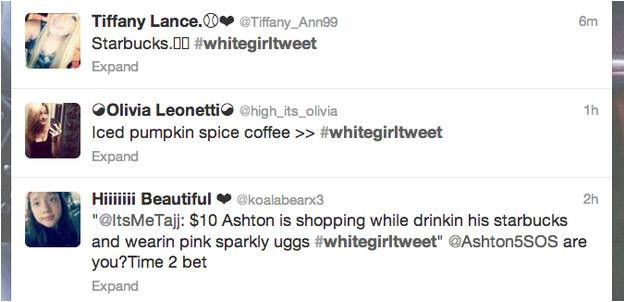
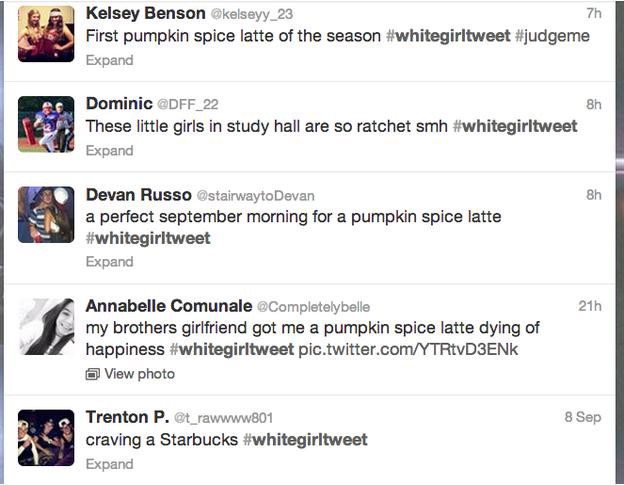
Verdict: 87% of whitegirl tweets are about Starbucks.
What’s particularly interesting about these photos is the way “treating yourself” keeps popping up. Pumpkins have always been associated in turns with simplicity and decadence, but usually pumpkin-obsessed Americans choose one or the other per generation and stick with it. This anxious “work hard play hard” thing is new. Bikini bod consumes PSL “Just this once,” the apology averring her babely norm. Office maven joins office early. “Least I could do,” she opines, “is spoil myself with a pumpkin.” Other times the causality is reversed, with pumpkin as incentive, not reward. I particularly enjoyed that the topic of one PSL study session was The Reformation, whose resistance to ceremony and pomp perfectly mirrors the pumpkin’s own attempts to cleanse. When I spoke with Dr. Cindy Ott, author of Pumpkin: The Curious History of An American Icon and to whose compendium I owe a big debt, she suggested that part of the appeal of the pumpkin as a dessert food is that it “it feels like you’re doing something good for yourself” — the perfect cultural balm for anyone chowing down on a pie, bread, or “with whip” latte. Add that to the cool factor of witchy 90s nostalgia and you’re in SEO heaven.
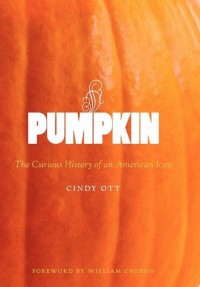
Cindy Ott’s Pumpkin: The Curious History of an American Icon is available wherever you prefer to purchase books. Dr. Ott teaches in the American Studies department of Saint Louis University and is also the author of “Crossing Cultural Fences: The Intersecting Material World of American Indians and Euro-Americans” and “Why Lewis and Clark Matter: History, Landscape and Regional Identity.”
The strange truth of the matter is that pumpkin’s associations are entirely imagined. Pumpkin is genetically identical to squash, and while squash — native only to the Americas — is privileged in most Native American religions, the orange globes we identify as pumpkin were treated with no special regard and were not served at the first American Thanksgiving nor carved for the first jack-o’-lantern.
Decadence, however, is an old association for squash, whose round shape and easy cultivation made the gourd a common target for creation and fertility tales. In Seneca and Huron mythology, for example, squashes sprout from a Great Spirit’s abdomen and head wherever she walks. The fecund associations of pumpkin were preserved by colonists who brought pumpkins back to Europe as souvenirs. Growth is even in the name — Europeans’ “Pumpkin” (earlier, “pompion”) comes from the Latin “Pepo,” which means to ripen or “cook by the sun” (OED).The first transatlantic squash seeds were disseminated through Europe as thank you gifts to royal patrons within 25 years of Columbus’s 1492 voyage, and pumpkin further permeated the market in the 16th century thanks to classicism, one of whose features was the fascination with Wunderkammer-like Herbals.
If you’re looking to simplify pumpkin’s history into a narrative of labor (I am), fertility poses somewhat of a problem, toeing as it does the line between decadence and simplicity. Pumpkin is decadently fertile, but in the Netherlands pumpkins became an icon of base nature and unsophistication — much like Josh’s boneheaded idea to inject his coffee with pumpkin in “Sabrina, the Teenage Witch.” In Joachim Beuckalaer’s The Country Market, for example, a woman gropes/is groped by pumpkin and man (respectively) in the hip hop-like pose of a woman prepared to get laid.
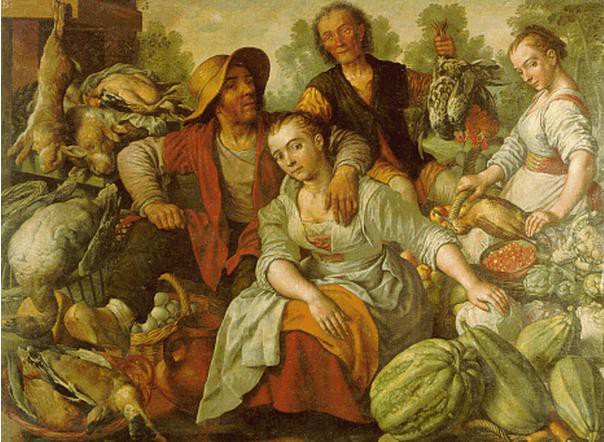
Joachim Beuckelaer (Dutch, 1533–1574), “The Country Market,” undated.
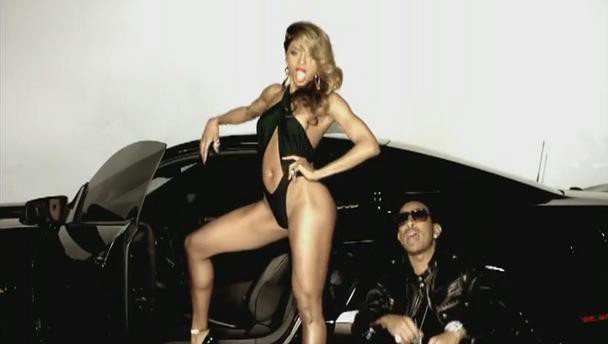
Just for fun. Still from Ciara’s “Ride,” ft. Ludacris (2010). Some things really are universal.
On the less sexy end of the rube spectrum, pumpkins have been associated with stupidity since the Roman philosopher Seneca auspicated the tradition of “pumpkinheads” in his rebuke of Emperor Claudius. And Falstaff, dum-dum par excellence, is characterized by Shakespeare as a “gross watery pumpion [pumpkin]” in The Merry Wives of Windsor. Like Claudius (and sort of Falstaff), the anthropomorphic pumpkin is always foolish yet aggressive: Before there were scarecrows and jack-o’-lanterns, Americans traded folk tales about animated vines and pumpkins so huge they had to be harvested by teams of axe-wielders, only to find their faith belied by a family of pigs trapped inside.
Although European treatment of pumpkins tended toward insult, Americans adopted the gourd as a positive symbol of New World perseverance. For example, a colonial song from from 1630 (reported in San Francisco’s 1891 Daily Evening Bulletin) reads:
Instead of pottage and puddings and custards and pies
Our pumpkins and parsnips are common supplies
We have pumpkins at morning and pumpkins at noon
If it was not for pumpkin, we should be undone
That being said, pumpkin was decidedly low class. New Englanders were called “Brother Jonathan and pumpkin pie” to signify their bumpkinhood and Puritans demeaned the pumpkin as callow and ill-restrained when they chastised — yes, chastised — Thanksgiving feasts as “St. Pompion’s Day.” Up until the 19th century, pumpkin was eaten primarily as slave and hog feed or as a poor man’s alternative to sugar cane, molasses, or malt.
A hole in that ideology is pumpkin pie. The first American cookbook, American Cookery (1796), featured a pie recipe loaded with rich cream and eggs. The recipe’s inclusion in a cookbook at all is notable, since lower class women worked mostly through oral tradition. But Cookery’s subtitle reads, “Adapted to this country, and all grades of life.”
Unlike Europeans, Americans had to contend with rural strandedness in a way that was trenchant yet inoffensive: thus, 58 years behind the first published pumpkin pie, we find the Hudson River School. In Walden, Henry David Thoreau addresses the pumpkin with a mix of reverence and condescension:
I would rather sit on a pumpkin and have it all to myself than be crowded on a velvet cushion. I would rather ride on earth in an ox cart, with a free circulation, than go to heaven in the fancy car of an excursion train and breathe a malaria all the way.
The pumpkin is an aesthetic object whose value is spiritually good but never rarefied. One suspects Thoreau’s review would be less glowing should the pumpkin seat a different occupant. The appeal is in coaptation of brain to nature; an actual hillbilly wouldn’t be celebrated.
Thoreau’s reference to a “fancy…train car” is no accident, either. Even in the 1800s, pumpkins — and the rural work ethic in general — were full of nostalgia for the pastoral imagined past. Thoreau’s is a longing for a place, time, and set of behaviors which will clean us out and make us good again. It is no accident that Thanksgiving became a national holiday in 1863, during civil war. Our collective nostalgia is not simply biographical — although it is true that farmers felt emasculated by industrialization — it is an epistemological nostalgia for innocence. To quote everyone’s favorite folly, Secretary of State William Seward, Thanksgiving (and its metonym the pumpkin) is “humble penitence for our national perverseness and disobedience.”
One side effect of Thanksgiving’s Civil War lineage is that family is front and center in all Thanksgiving-themed conversations — a function, in part, of Seward’s suggestion that Americans pay mind to the ubiquity of “harmony” “everywhere except in the theatre of military conflict” and the tendency of abolitionists and civil war pundits to talk politics through the metaphor of domestic living. Pumpkin also has strong family connotations, thanks to the communities in which it was grown during America’s inception — generally, family farms or plantations.
But by the mid-late 1800s agriculture trends were all about big crops like corn and cotton, and in 1870 The Horticulturalist remarked, “It is about time that pumpkins were retired from service and entered upon the fossil list.” Ironically, it’s the very anachronism of pumpkin as agriculture that contributed to its romantic image. As the invent of state parks attest, 19th century Americans preferred to keep their nature intimate yet physically removed. The same year The Horticulturalist called pumpkin a fossil, the American Agriculturalist featured a pumpkin on their masthead. Farmers at this time grew mammoth pumpkins for prizes at state fairs, not as subsistence or commodity crops. The further pumpkin got from the real American economy the more it became ballast for our identity as hard workers.
Just as pumpkin connotes family, in the late 19th century some of those family values spilled over into moralizing Victorian tales who use animated pumpkins to distinguish between good and bad behavior. My favorite is a story read to me during my own childhood — William D. Howells’s The Pumpkin-Glory, in which “there were two little pumpkin seeds, and one was a good little pumpkin seed, and the other was bad — very proud, and vain, and ambitious.” There are some great holes built into the story’s own ideology, but the tl;dr is that a pumpkin seed dreams of becoming a morning glory, is derided by family, falls in a barn, and is eaten by a sow. The “good pumpkin seed” brother knows his place, becomes a predictable pumpkin, is made into pie. Good ol’ 1892. Also, this happens: “It was like getting scalped, but the pumpkin didn’t mind it, because it was just the same as war.”
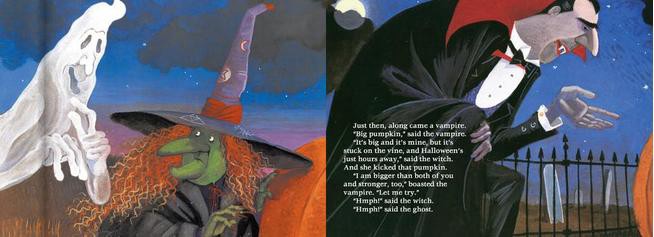
Pages from “Big Pumpkin,” by Erica Silverman (1992). Technically not Victorian but the formula is the same: Family + Labor = Childhood = Pumpkin.
It’s incredible how formulaic cultural associations are when it comes to pumpkin. One of the most glaring facts of my social media survey of the pumpkin spice latte was how many PSL Instagrammers were female and white. I suspect this has less to do with actual consumer demographics and more to do with branding — the Pumpkin Spice Latte has an image that is in some way consistent with whiteness and femininity. (Not to muddy the waters, but for one thing, unlike pumpkin, the PSL is a dessert, which has its own gendered expectations.) My guess is that the PSL #whitegirltweet is about compliance and agency: white girls are expected to be unabraisive and docile — young women who still obey their fathers. Abstracting #whitegirl to those levels is useful because similar associations pop up in the late 1800s with the Victorians’ and Romantics’ mutual fixation on childhood.
Pumpkins are a particularly good icon of ungreedy labor because besides not being worth much they cannot be farmed with machines. Mammoth pumpkin raising guides repeatedly reference the fickleness of the gourd, whose genetics only vaguely predict color and thus saleability. When harvesting pumpkins, most of the work must be done manually. Technology was entirely out of the equation until 1955, when for the first time farmers stopped cutting the seasonal fruit from the vine by hand. Almost no machine can be used on ornamental pumpkins because the skin must remain pristine, and unlike other vegetable crops, pumpkins really are grown mostly on small family farms, though often these family ventures sell the experience of pumpkin picking, not actual pumpkins.
This labor-intensive, modest family ideology is so compelling that canned pumpkin behemoth Libby’s (Nestle) even sells this vision to their very farmers. According to Cindy Ott, “Rather than illustrating [Nestle’s] 2000 annual report with the most advanced and up-to-date equipment used to harvest and process pumpkins, the cover featured Newhauser, who was wielding a small pocketknife in the middle of a pumpkin field.”
If pumpkin is so modest, how did it become the carb of sophisticates? For one thing, the midcentury fixation on canning made unadulterated unprocessed pumpkin the sort of add-in only Martha Stewart (or these days, Smitten Kitchen) types could will themselves to pull off. Similarly, in a perfect synchrony between art and economics, mid-century kitsch by way of Norman Rockwell and (sorry, but) Charlie Brown made the ideal pumpkin perfectly round and glowingly orange, with beefy annulations — to which Post-Fordist family farm style zeitgeist has responded by encouraging the purchase of “heirloom pumpkins,” which you can now buy from Whole Foods.
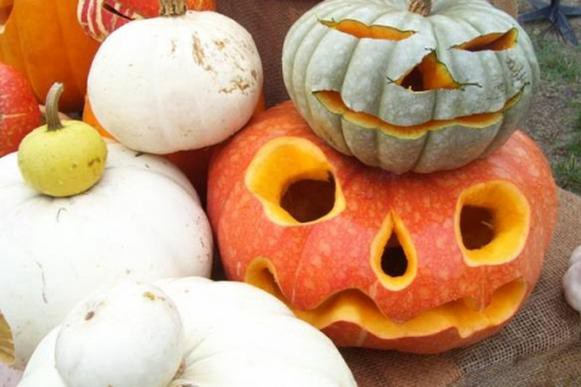
Heirloom Pumpkins at Whole Foods.
And because pumpkin is obviously a dessert, amp up your kitchen cred by using pumpkin as a bowl from which to serve your rustic black bean pumpkin soup, which Smitten Kitchen describes as perfect accompaniment to “a crusty piece of bread, …substantial enough to be a meal.” Thanks to the overpowering normalcy of midcentury pumpkin iconography, post Fordist pumpkins can afford to be both sophisticated and modest.
When I spoke with Dr. Ott over the phone I asked her if she thought our attitude toward the rural work ethic had changed since Thoreau’s time. “This isn’t ideological,” she said, “but one basic difference is that a lot of those people were raised on farms and then moved to cities….People stress about going back to this good basic way of life even though they’re not sure what exactly that entails….It resonates deeply that we got rid of all the farms. It was erasing a deep part of who we are. It becomes this cultural, national heritage as opposed to this specific change within families leaving the farm and going into the city.” Though that doesn’t explain whether we are any more or less condescending now than in 1854, it at least explains why farm realism takes the form of warty gourds and not pumpkins with nicks in their skin — “authentic” pumpkins contain only imagined blemishes.
The other big change, of course, is that pumpkins are now also mischievous — a weird afterthought for a squash dedicated otherwise to advertising our wholesomeness. The first jack-o’-lanterns (an Irish tradition, if the name didn’t give it away) were actually carved out of turnips. Jack-o’-lanterns weren’t recognizable to the American public in any form until the late 19th century, although its antecedents (Will-o-the-wisp, the “The Legend of Sleepy Hollow”’s Headless Horseman, Nathaniel Hawthorne’s “Feathertop”) predate full-on jack-o’-lanterns by about 50 years. It wasn’t until 1897 that the Ladies Home Journal suggested, “To add weirdness and quaintness, have plenty of jack-o’-lanterns made of pumpkins” — clearly still novel, though to be fair, “quaint” and “weird” remain on-trend today. Spookiness probably isn’t about labor — but it is about nostalgia and the last gasps of childhood, only a stone’s throw away from the anxiety that permeates more wholesome pumpkin Americana.
In the last two decades, Halloween mystique has ballooned, thanks dually to the ever-enthralling gleam of Christmas Creep and the nineties’s witch fetish. The Pumpkin Spice Latte is itself actually a product of Christmas Creep. When I emailed Melody Overton, who runs the popular Starbucks blog, Starbucks Melody, she wisely pointed out that “[I]n 1986, the Eggnog Latte was an October beverage. But now the Eggnog Latte is a November beverage as fall has developed and taken on its own unique celebratory feel.”
#PSL = proof that fall loves you.
— Starbucks Coffee (@Starbucks) October 4, 2013
Certainly pumpkin’s star was rising before 2003, the year of PSL’s debut. But in the last decade, pumpkin’s connection to Starbucks has become indelible (even with McDonald’s introducing their very own, and much less expensive, Pumpkin Spice Latte). The drink is, to quote Starbucks Melody, “dessert in a cup…part of that cultural fall [sic] wallpaper.” Her otherwise flattering diction intrigued me. Cultural wallpaper? It has been remarked (by Roland Barthes, no less) that modern advertising portrays certain foods as both stimulant and opiate:
For centuries, coffee was considered a stimulant to the nervous system…but contemporary advertising, while not expressly denying this traditional function, paradoxically associates it more and more with images of “breaks,” rest, and even relaxation. What is the reason for this shift? It is that coffee is felt to be not so much a substance as a circumstance. (PDF)
Likewise, “feelings of guilt [were] fostered by an advertising for sugar which emphasized pure enjoyment.” Pumpkin’s synchrony with sweet coffee is incredible: like regular coffee, the PSL is decadence tempered by labor, stimulating yet relaxing. It is a way of spoiling yourself that you earn. And, like sugar’s sweet spot, the PSL is not pure bliss: remember, you worked hard to deserve it. In this way, Melody’s description of the Pumpkin Spice Latte is telling: it is “cultural fall wallpaper” — that is, like a snack (but on a seasonal rather than daily scale), both routine and celebratory.
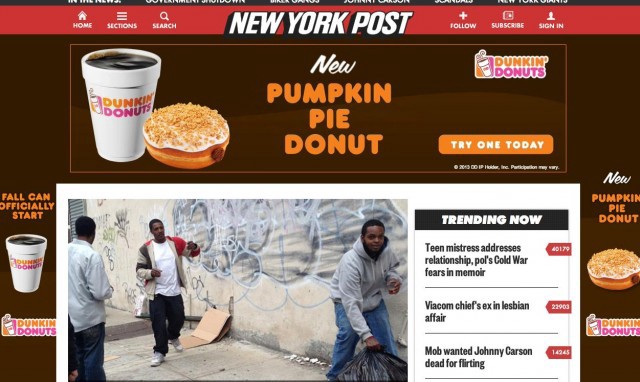
“Fall can officially start” is the marketing slogan for Dunkin’ Donuts’ “pumpkin pie donut.”
Pumpkin’s current position as icon of cool is particularly confusing because coolness is neither wanton nor modest — it requires of its wielders emotional restraint and consumerist peacocking. But perhaps it is this very tension in the ideology of cool that makes pumpkin so appealing to contemporary palettes — split evenly between decadence and modesty and wracked by a peculiarly American guilt, the pumpkin is the coolest melon around.
Johannah King-Slutzky is confused. She writes poems and blogs about TV here. Follow her on twitter @jjjjjjjjohannah.
